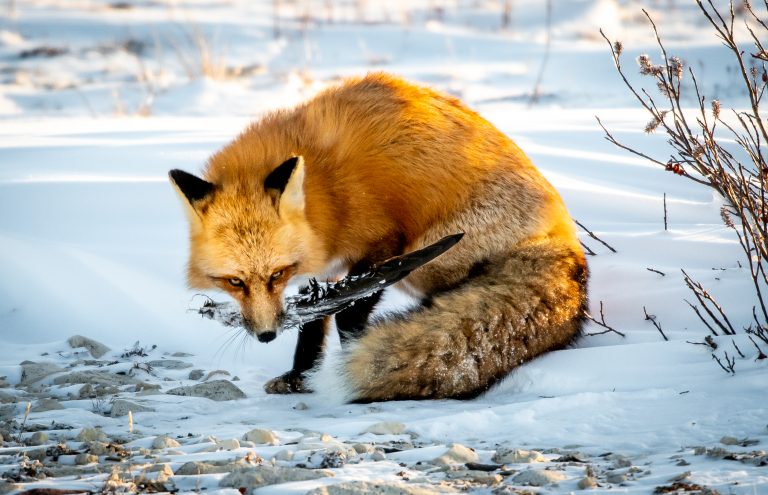Red fox moving north could mean the end of the arctic fox. The red fox pictured here pauses after digging up a bird feather from his cache in the arctic. Photo by Michele Theall.
Bold and brazen, the red fox moves across the swirling shawl of winter tundra, hunting for birds, digging up food caches, and evicting the more diminutive arctic foxes from their centuries-old dens. After 15 years of traveling in various Arctic regions, I’ve noted the hostile takeover firsthand. In general and using simplistic, non-scientific observation, I simply see more red fox than arctic fox now, when the reverse was true a decade ago—and I attribute it to climate change. According to polar researchers, my assumptions are spot on: The red fox’s northward migration is real and a direct result of a warming Arctic.
Changing territory
To understand what’s taking place, consider the preferred territory for each fox species.
Red fox thrive in warm temperatures and shrublands close to or below tree line. Tree line is shifting north, a phenomenon visible on any drive along the Haul Road from Fairbanks to Deadhorse through the Brooks Range. Scientists note the replacement of the lichen and moss-dominated artic fox range by an infiltration of bushes and woodlands, including prominent stands of dwarf birch, willow, and white spruce. As shrubland takes over tundra, the red fox expands its territory, following the similar migration of its preferred food sources of small prey that can feed, survive, and hide in an increasingly more hospitable northern environment.
Arctic fox, ideally adapted to sub-zero climes, employ hunting styles uniquely suited to ice and snowpack. For food, the arctic fox subsists largely on tundra-dwelling lemmings, rodents living in burrows under snow. Additionally, when lemming populations decline (as they do with the rising temps), the arctic fox rely on sea pack ice to scavenge polar bear leftovers and supplement their diet. As these food sources dwindle with the ice, the arctic fox must find other ways to adapt—which can be made more difficult as the red fox begins to prey on its smaller cousin.

Predation and den competition
In recent years, multiple instances of red fox hunting arctic fox have been documented by researchers. Scientists in Sweden report numerous occasions of red fox invading arctic fox dens and consuming arctic fox cubs, as well as adult arctic fox. This new behavior likely comes with the opportunistic feeding nature of the red fox as it moves into expanded hunting territory, only to find an arctic fox—a creature resembling a rabbit in size and coloration, easy prey for the larger carnivore. On St. Matthew Island, almost 200 miles off the Alaskan coast in the Bering Sea, red fox have all but decimated the arctic fox population. A 2017 study published in the Canadian Journal of Zoology found that the island was colonized by at least three mitochondrial matrilines of red fox, postulating that we may have underestimated the ability of red fox to disperse over ice or ocean.
In addition, as the red fox has moved north, researchers have observed red fox laying claim to arctic fox dens with aggressive and territorial behavior. One 2014 study on fox den occupancy in Prudhoe Bay noted a sizeable and irreversible turnover of den sites over a seven-year period. In 2005, 85 percent of dens were occupied by arctic fox. By 2012, those same dens were occupied by red fox, and once a den was vacated by an arctic fox, it never returned. A study of fox populations in the Scandinavian Arctic portends a grim future for the arctic fox. Arctic fox numbers there are as low as 120 individuals, and in areas where red fox exist, arctic fox are completely absent. In fact, they only recolonized in areas where red fox had been culled. They have not been found to co-exist for very long in the same environment.
Population
For now, arctic fox numbers in North America remain stable—though to find viable territory without their nemesis, the arctic fox must head farther and farther north, where they’ll avoid the red fox for a while, but will encounter the warmest trending of Arctic temperatures in recorded history, including a record high this summer of 100.4 F. Could this mean the end of the arctic fox? The question is: Will they run out of places to run or learn to adapt? Only time will tell.



Comments are closed.